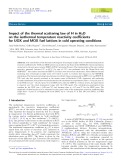
REGULAR ARTICLE
Impact of the thermal scattering law of H in H
2
O
on the isothermal temperature reactivity coefficients
for UOX and MOX fuel lattices in cold operating conditions
Juan Pablo Scotta
1
, Gilles Noguere
1
,*
, David Bernard
1
, Jose Ignacio Marquez Damian
2
, and Alain Santamarina
1
1
CEA, DEN, DER Cadarache, Saint Paul les Durance, France
2
Neutron Physics Department and Instituto Balseiro, Centro Atomico Bariloche, CNEA, Bariloche, Argentina
Received: 25 November 2015 / Received in final form: 24 February 2016 / Accepted: 23 March 2016
Abstract. The contribution of the thermal scattering law of hydrogen in light water to isothermal temperature
reactivity coefficients for UOX and MOX lattices was studied in the frame of the MISTRAL critical experiments
carried out in the zero power reactor EOLE of CEA Cadarache (France). The interpretation of the core residual
reactivity measured between 6 °Cto80°C (by step of 5 °C) was performed with the Monte-Carlo code
TRIPOLI4
®
. The nuclear data from the JEFF-3.1.1 library were used in the calculations. Three different thermal
scattering laws of hydrogen in light water were tested in order to evaluate their impact on the MISTRAL
calculations. The thermal scattering laws of interest were firstly those recommended in JEFF-3.1.1 and ENDF/B-
VII.1 and also that recently produced at the atomic center of Bariloche (CAB, Argentina) with molecular
dynamic simulations. The present work indicates that the calculation-to-experimental bias is 0.4 ±0.3 pcm/°C
in the UOX core and 1.0 ±0.3 pcm/°C in the MOX cores, when the JEFF-3.1.1 library is used. An improvement
is observed over the whole temperature range with the CAB model. The calculation-to-experimental bias
vanishes for the UOX core (0.02 pcm/°C) and becomes close to 0.7 pcm/°C for the MOX cores. The
magnitude of these bias have to be connected to the typical value of the temperature reactivity coefficient that
ranges from 5 pcm/°C at Begining Of Cycle (BOC) up to 50 pcm/°C at End Of Cycle (EOC), in PWR
conditions.
1 Introduction
The isothermal temperature reactivity coefficients, or
equivalently the reactivity temperature coefficients
(RTC), are one of the major reactor safety parameters.
They represent the change in reactivity due to a change
in temperature [1]. Recent publications deal with RTC
for various reactor configurations in “cold conditions”
(T<50 °C) [2–4] up to “hot conditions”(T<300 °C)
[5,6]. The present work focuses on the calculation of RTC
for critical assemblies in “cold conditions”for temper-
atures ranging from 6 °Cto80°C at atmospheric pressure.
The isothermal temperature coefficient a
iso
(T)isdeter-
mined from the excess of reactivity r(T)measuredat
given temperatures T. In practice, the experimental
results allow estimating Da
iso
(T) which represents the
calculation error on RTC. The latter is given by the
derivative of the difference Dr(T) between the calculated
(C) and measured (E) excess of reactivity with respect to
the temperature:
DaisoðTÞ¼∂DrðTÞ
∂T;ð1Þ
with
DrðTÞ¼rCðTÞrEðTÞ:ð2Þ
A series of MISTRAL experiments [7–15] was carried
out in the EOLE facility of CEA Cadarache (France)
in order to study Da
iso
for UOX (MISTRAL-1
configuration) and MOX (MISTRAL-2 and MISTRAL-
3configurations) lattices. Previous interpretations
[16,17] were performed with the deterministic code
APOLLO2 [18] by using the evaluated nuclear data
libraries JEF-2.2 and JEFF-3.1.1. Results are summarized
in Table 1. According to conclusions reported in
reference [16],Da
iso
is mainly sensitive to the spectral
shift of thermal neutrons in the low temperature range
(T<40 °C). The contribution of the water density effects
becomes sizeable when the temperature increases. In
addition, the contribution of the thermal spectrum effects
* e-mail: gilles.noguere@cea.fr
EPJ Nuclear Sci. Technol. 2, 28 (2016)
©J.P. Scotta et al., published by EDP Sciences, 2016
DOI: 10.1051/epjn/2016020
Nuclear
Sciences
& Technologies
Available online at:
http://www.epj-n.org
This is an Open Access article distributed under the terms of the Creative Commons Attribution License (http://creativecommons.org/licenses/by/4.0),
which permits unrestricted use, distribution, and reproduction in any medium, provided the original work is properly cited.





















